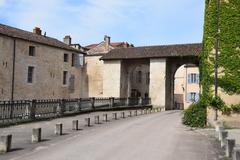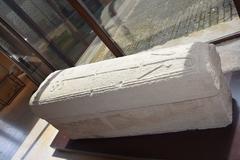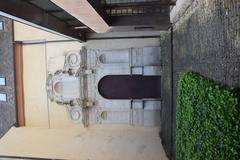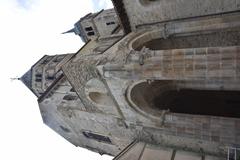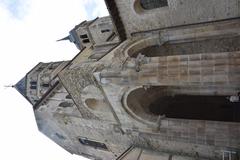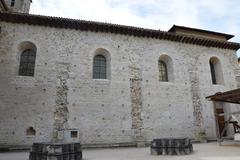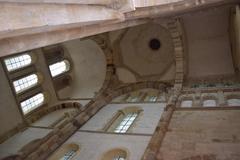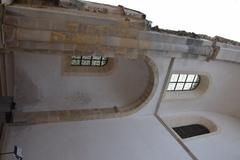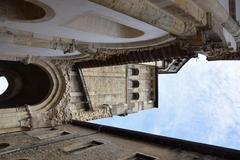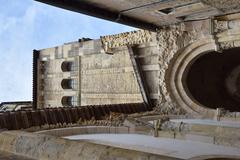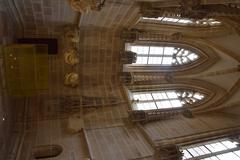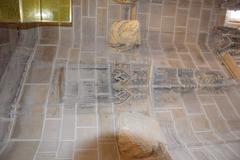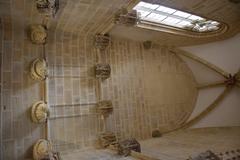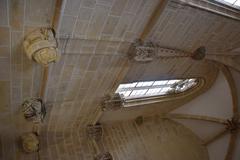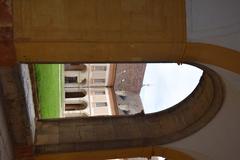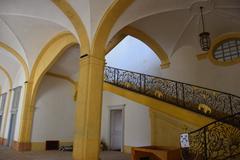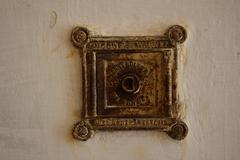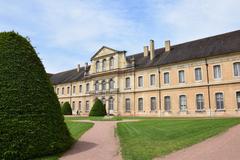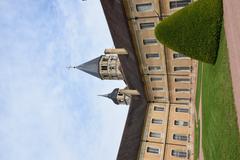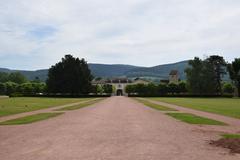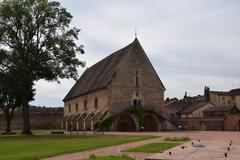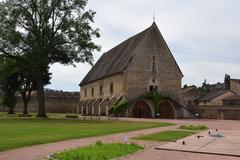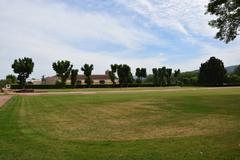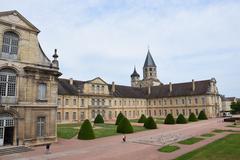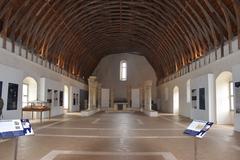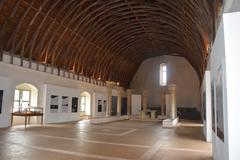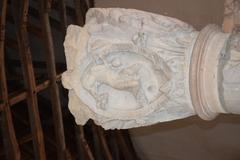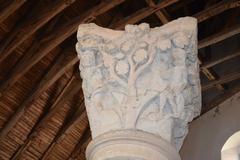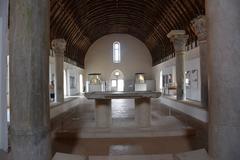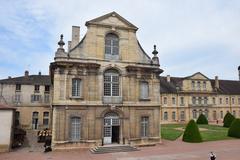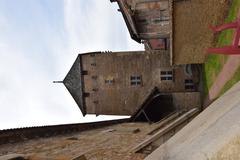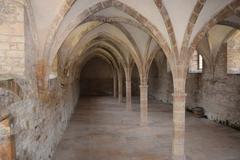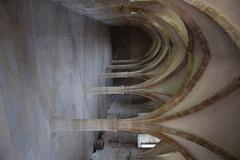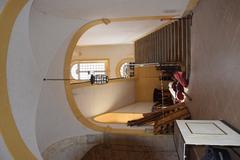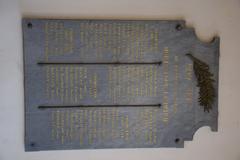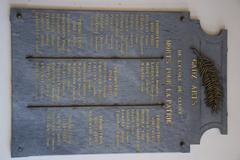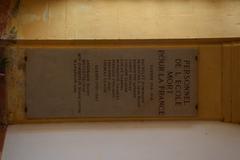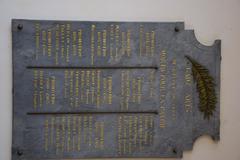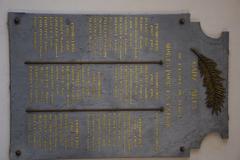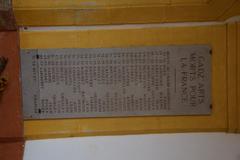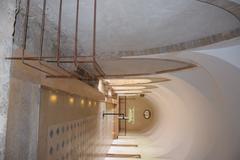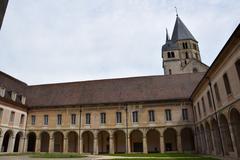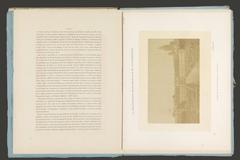
Cluny III Visiting Hours, Tickets, and Historical Sites Guide in Cluny, France
Date: 15/06/2025
Introduction to Cluny Abbey
Cluny Abbey, situated in the scenic Burgundy region of France, stands as a monumental testament to medieval religious architecture and European cultural heritage. Founded in 910 by William the Pious, Duke of Aquitaine, the abbey became the heart of a vast monastic network and a center for spiritual reform. Its most impressive phase, Cluny III, initiated in 1088 under Abbot Hugues de Semur, was for centuries the largest church in Christendom, admired for its monumental Romanesque style, ambitious scale, and architectural innovations. Today, although much of the original structure was destroyed, the surviving ruins, museum, and digital reconstructions provide an immersive experience for visitors interested in history, architecture, and spirituality (franceguide.info, wikipedia, gralon.com).
This guide covers everything you need for your visit—including opening hours, ticketing, practical details, and an overview of Cluny’s historical significance.
Table of Contents
Historical Overview
Origins and Foundation
Founded in 910, Cluny Abbey was established as a center of monastic reform, advocating the Rule of Saint Benedict. Its early success led to rapid expansion, making it the motherhouse for a network of over 1,000 dependent priories by the 12th century (franceguide.info). The construction of Cluny III, starting in 1088, aimed to reflect the spiritual and worldly prestige of the Cluniac order (wikipedia).
Architectural Significance
Cluny III was a marvel of Romanesque architecture and, for centuries, the largest church in the Christian world until it was surpassed by St. Peter’s Basilica. The church stretched over 187 meters in length, with vaults soaring up to 30 meters high. Its five naves, double transept, and grand choir were notable architectural achievements (gralon.com). Features such as stone-vaulted ceilings, a luminous tripartite elevation, and rich sculptural decoration influenced Romanesque and Gothic architecture throughout Europe (zoraholidays.net).
Role in Medieval Europe
At its peak, Cluny Abbey was not just a religious institution but a major political, cultural, and intellectual force. It introduced liturgical reforms, produced illuminated manuscripts, and played a key role in European monasticism. The abbey’s spiritual influence was matched by its wealth, with generous endowments fueling construction and artistic patronage (wikipedia).
Decline and Modern Rediscovery
Cluny’s influence waned in the late Middle Ages, particularly with the rise of stricter orders like the Cistercians. During the French Revolution, much of the abbey was destroyed, and its stones were sold off. Today, only about 10% of the original structure remains, but ongoing excavations, museum collections, and digital reconstructions allow visitors to appreciate its former grandeur (gralon.com).
Visiting Information
Opening Hours & Tickets
-
April 1 – June 30: 9:30 am – 6:00 pm
-
July 1 – August 31: 9:30 am – 7:00 pm
-
September 1 – 30: 9:30 am – 6:00 pm
-
October 1 – March 31: 9:30 am – 5:00 pm
(Last entry: 45 minutes before closing)
(Cluny Abbey practical info) -
Standard Ticket: ~€11–12 (2024)
-
Reduced Rate: Available for students, job seekers, families
-
Free Entry: For EU residents under 26
-
Combined Tickets: Include access to the Cheese Tower and museum
-
Audioguides: €3 (French, English, German, Italian)
-
Children’s Booklets: Available in French (French and Travelers)
Tickets can be bought onsite or online. Advance booking is recommended in peak season.
Highlights & What to See
- Grand Transept and Nave: Surviving portions illustrate the abbey’s monumental scale. Augmented reality terminals on-site digitally reconstruct the vanished sections (France Travel Planner).
- Cloisters: Elegant arcades and peaceful gardens reflect monastic life.
- Jean de Bourbon Chapel: Late Gothic funerary chapel with notable sculptures.
- Farinier (Monks’ Refectory): Medieval wooden roof, 3D film, and exhibitions.
- Museum of Art and Archaeology: Sculptures, stained glass, and manuscripts (Cluny Abbey Official).
- Tour des Fromages (Cheese Tower): Panoramic views of Cluny and Burgundy.
- Smaller Chapels & Fortifications: Remnants of the abbey’s defensive and spiritual functions.
Visitor Experience
- Guided Tours: Included in ticket price, available in multiple languages.
- Self-Guided Visits: Use audioguides and children’s booklets for independent exploration.
- Augmented Reality & 3D Films: Enhance the experience by visualizing the original church structure (cluny-abbaye.fr).
- Special Events: Concerts, festivals, and exhibitions are held throughout the year (Cluny Abbey Official).
Accessibility & Services
- Accessibility: Key areas are wheelchair accessible; some towers and stairs may be challenging. Contact the site for accommodations (Cluny Abbey practical info).
- Facilities: Restrooms, gift shop, and an information desk are available. Electric car charging stations are located at rue Porte de Paris.
- Safety: The site complies with France’s Vigipirate security plan; bag checks may occur.
Events & Photographic Spots
- Photo Opportunities: The cloisters, Cheese Tower, and panoramic ruins are especially photogenic.
- Annual Events: Heritage Days, concerts, and themed festivals. Check the official calendar for details.
Getting There
- By Car: Accessible via D980, ample pay parking at the Prado car park.
- By Train: Mâcon-Loché TGV station (25 km away) + bus (Line LR 701) to Cluny.
- By Bike: The Voie Verte cycling route connects Cluny with Mâcon and Chalon-sur-Saône.
- By Bus: Regional lines LR 701 and LR 709 from nearby towns (Cluny Abbey practical info).
Visitor Tips
- Best Time to Visit: Early mornings or weekdays in June or September for fewer crowds.
- Allow Enough Time: 2–3 hours recommended for the abbey, museum, and tower.
- Combine with the Town: Explore Cluny’s medieval streets, local markets, and nearby Romanesque churches.
- Check for Closures: Special events may impact access or hours.
FAQ
Q: Are guided tours available in English?
A: Yes, guided tours and audioguides are offered in multiple languages.
Q: Can I buy tickets online?
A: Yes, online ticketing is available and recommended during peak times.
Q: Is the site accessible for visitors with disabilities?
A: Most key areas are accessible, but some towers have stairs. Contact the site for details.
Q: Are there parking and electric charging facilities?
A: Yes, ample parking (pay lots) and free 24/7 electric car charging at rue Porte de Paris.
Q: What are the best photographic spots?
A: The Cheese Tower, cloisters, and nave ruins provide excellent photo opportunities.
Conclusion
Cluny Abbey is a destination of tremendous historical, architectural, and spiritual weight. Even in ruin, its scale and artistry are awe-inspiring. By planning ahead—checking seasonal opening hours, securing tickets online, and exploring both the abbey and the medieval town—you can make the most of your visit. Modern interactive technologies, such as augmented reality, bring Cluny’s past vividly to life, while guided tours and exhibitions deepen understanding of its enduring legacy.
For up-to-date information and event schedules, always consult the official Cluny Abbey website. Enhance your visit with the Audiala app for guided audio tours and explore related articles for a broader look at Burgundy’s heritage.
References
- The Abbey of Cluny in Burgundy: A Place Steeped in History (Gralon)
- Cluny Abbey (Wikipedia)
- Cluny Abbey Visiting Hours, Tickets, and Historical Guide (France Guide)
- Cluny Abbey Official Website
- Discover Cluny Abbey: Visiting Hours, Tickets, and Architectural History (French and Travelers)
- Cluny Abbey Practical Information (Burgundy Tourism)
- Cluny III Visiting Hours, Tickets, and Must-See Historical Sites in Cluny (France Travel Planner)
